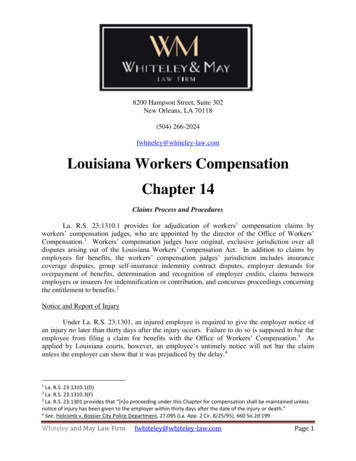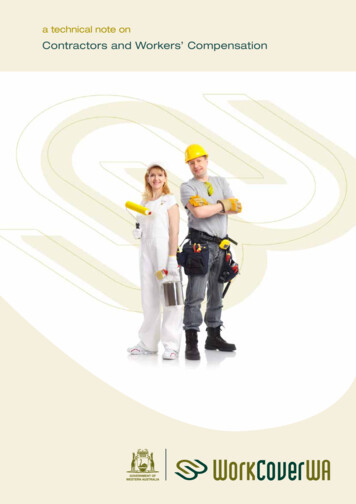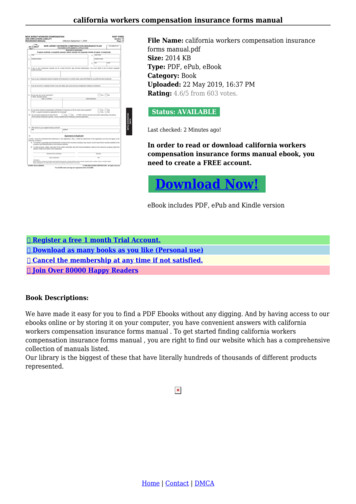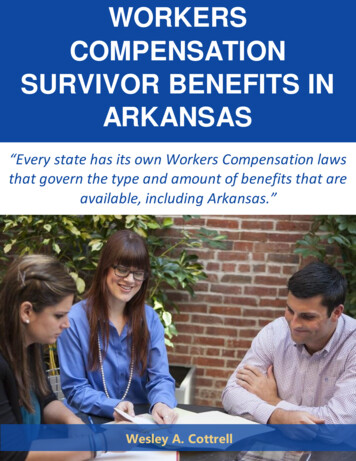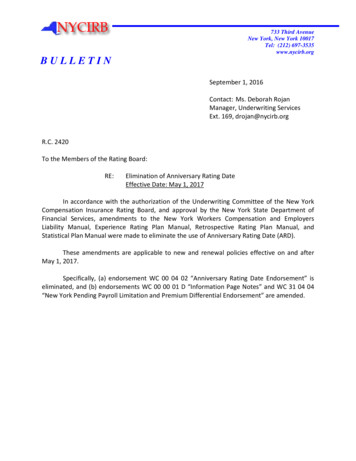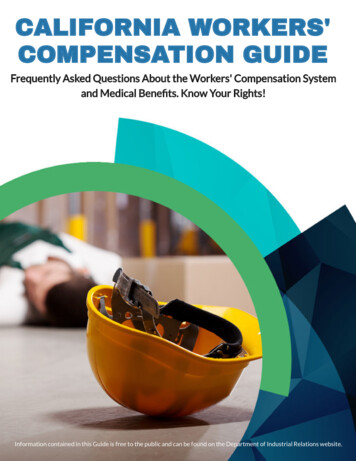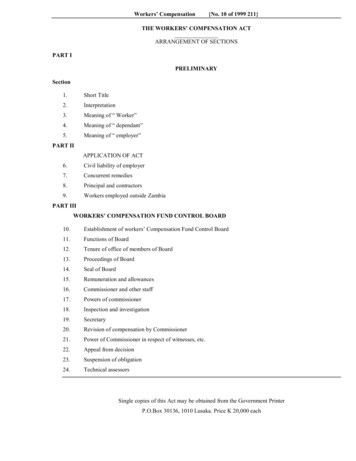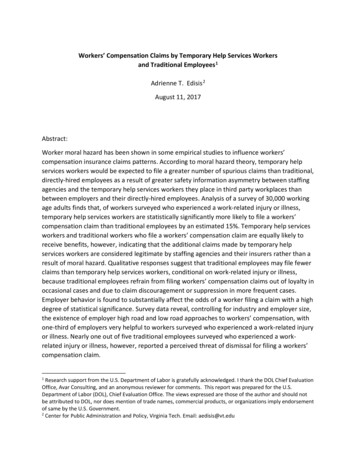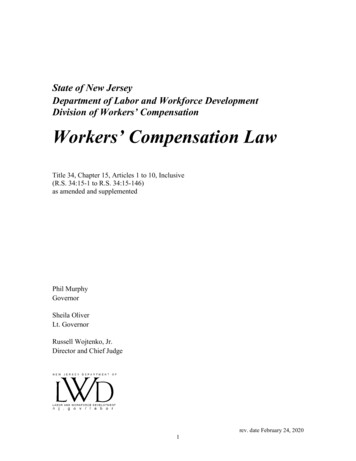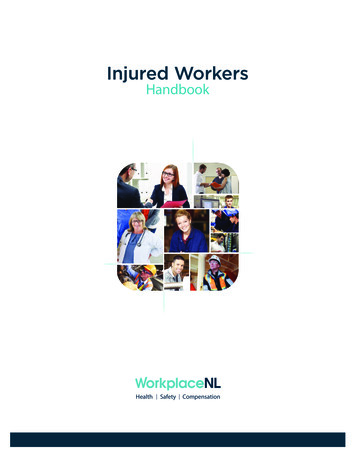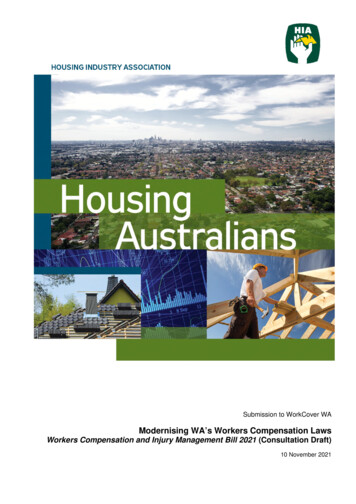
Transcription
Submission to WorkCover WAModernising WA’s Workers Compensation LawsWorkers Compensation and Injury Management Bill 2021 (Consultation Draft)10 November 2021
ABOUT THE HOUSING INDUSTRY ASSOCIATION .21.INTRODUCTION.32.GENERAL COMMENTS .33.PART 1 - PRELIMINARY .84.PART 2 - COMPENSATION FOR INJURY .115.PART 3 – INJURY MANAGEMENT.176.PART 5 - INSURANCE .207.PART 6 – DISPUTE RESOLUTION .218.PART 7 – COMMON LAW.219.PART 10 – MANAGEMENT AND DISCLOSURE OF INFORMATION .2210. PART 14 – SAVINGS AND TRANSITIONAL PROVISIONS .23Housing Industry Association contacts:Cath HartExecutive DirectorHousing Industry Association22 Parkland RoadOSBORNE PARK WA 6017Phone: 08 9492 9200Email: c.hart@hia.com.au-i-
ABOUT THE HOUSING INDUSTRY ASSOCIATIONThe Housing Industry Association (HIA) is Australia’s only national industry association representingthe interests of the residential building industry.As the voice of the residential building industry, HIA represents a membership of 60,000 acrossAustralia. Our members are involved in delivering more than 170,000 new homes each year throughthe construction of new housing estates, detached homes, low & medium-density housingdevelopments, apartment buildings and completing renovations on Australia’s 9 million existinghomes.HIA members comprise a diverse mix of companies, including volume builders delivering thousandsof new homes a year through to small and medium home builders delivering one or more custombuilt homes a year. From sole traders to multi-nationals, HIA members construct over 85 per cent ofthe nation’s new building stock.The residential building industry is one of Australia’s most dynamic, innovative and efficient serviceindustries and is a key driver of the Australian economy. The residential building industry has a widereach into the manufacturing, supply and retail sectors.Contributing over 100 billion per annum and accounting for 5.8 per cent of Gross Domestic Product,the residential building industry employs over one million people, representing tens of thousands ofsmall businesses and over 200,000 sub-contractors reliant on the industry for their livelihood.HIA exists to service the businesses it represents, lobby for the best possible business environmentfor the building industry and to encourage a responsible and quality driven, affordable residentialbuilding development industry. HIA’s mission is to:“promote policies and provide services which enhance our members’ business practices, productsand profitability, consistent with the highest standards of professional and commercial conduct.”HIA develops and advocates policy on behalf of members to further advance new home building andrenovating, enabling members to provide affordable and appropriate housing to the growingAustralian population. New policy is generated through a grassroots process that starts with localand regional committees before progressing to the National Policy Congress by which time it haspassed through almost 1,000 sets of hands.Policy development is supported by an ongoing process of collecting and analysing data, forecasting,and providing industry data and insights for members, the general public and on a contract basis.The association operates offices in 22 centres around the nation providing a wide range of advocacy,business support services and products for members, including legal, technical, planning, workplacehealth and safety and business compliance advice, along with training services, contracts andstationary, industry awards for excellence, and member only discounts on goods and services.Page 2 of 23 Workers Compensation and Injury Management Bill 2021
1. INTRODUCTIONA review of WA’s workers compensation laws has been underway since 2009. Driven by a numberof election promises by the current Government in 2021, the Workers Compensation and InjuryManagement Bill 2021 (Consultation Draft) (the Draft Bill), was released by WorkCover WA on 11August 2021 for public consultation.In addition to the Workers Compensation and Injury Management Act 1981 (Act), the Draft Billproposes minor changes to the following: Civil Liability Act 2002Fire and Emergency Services Act 1998Insurance Commission of Western Australia Act 1986Motor Vehicle (Catastrophic Injuries) Act 2016Motor Vehicle (Third Party Insurance) Act 1943A comprehensive suite of supporting documentation has also been released with the Draft Bill,including: the Guide to the Draft Bill;58 Information Sheets;the Comparison with Current Act by Key Provisions; andthe Comparison with Current Act by Section Number; andmark-ups of the Acts amended by the Bill.The supporting documentation states that the WA workers compensation framework will remainlargely the same. However, various key changes have been highlighted throughout the Draft Billwhich will have an impact on insurance premiums and administrative processes for employers.HIA takes this opportunity to respond to WorkCover WA’s request for feedback on the parts of theDraft Bill that seek to amend the Act.2. GENERAL COMMENTSThe residential building industry in Western Australian has recently seen an increase in activitybeyond all expectations. This follows a five-year period of extremely low activity.Labour and skills shortages have been the result of a previous reduction in capacity and restrictionson international travel. Material and product shortages have also arisen as a result global shippingand manufacturing challenges. Increased demand for scarce commodities has exacerbated theseissues and prices have skyrocketed.Builders who have entered into fixed price contracts with limited avenues to pass on the priceincreases they are experiencing, are now carrying a high level of financial risk. Further factorscontributing to price increases include delays outside of the builder’s control, such as approval offinance or permits. With delays also occurring within milestone progress stages, builders arerequired to carry progressive costs for the work for longer periods of time and milestone paymentsare being pushed back, putting pressure on their cash flow.Currently, the residential building industry is not well-placed to be dealing with substantial additionallegislative change or additional overhead costs.Page 3 of 23 Workers Compensation and Injury Management Bill 2021
2.1.INSURANCE PREMIUMSWorkCover premiums are usually the largest single government on-cost for employers. Based onthe proposed changes, HIA’s biggest concern is the potential for significant increases to insurancepremiums.While many changes proposed don’t materially impact the operation of the workers compensationlaws, the proposal to increase the cap on medical expenses and extend the step-down period forincome compensation are matters of concern. These two significant changes will undoubtedly resultin an increase to insurance premiums.The question remains as to whether the estimated 2-3% increase in premiums is a reasonable andaccurate estimate. It is noted that WorkCover WA has had the cost impact of these changesassessed, however no evidence or supporting information for these figures appears to have beenprovided.The initial impact of an increase in premiums will be felt by the employer, however in the residentialbuilding industry these costs are inevitably passed up the contractual chain. In a residential context,subcontractors pass costs on to builders, who then pass costs on to homeowners.The result is a compounding of additional insurance costs in the contract price for a new home. Thisdoesn’t convert to an increase in the value of the home for the consumer, but instead results inreduced housing affordability. This cost is also not necessarily applied proportionately to the contractprice and could see homeowners at the lower end of the market experiencing steeper increases thanthose at the higher end of the market.Maximum insurance premium rates will not be prescribed under the new laws; however, a scheduleof recommended rates for different industries and business categories will be provided. Where aninsurer intends to charge in excess of 75% above the recommended rates, it will need to seekapproval from WorkCover WA. This is in accordance with the current process.In the same way that mining and resources construction is different to commercial construction, it isimportant for a clear distinction to be made between different construction types. For example, theconstruction of a single residential detached dwelling is very different to multi-residentialconstruction, and similarly small-scale commercial versus medium-to-large scale commercialconstruction. The operating methods, site hazards and level of risk, are distinctly different betweendifferent construction types, resulting in entirely different injury outcomes.Under section 256, WorkCover WA will be required to issue an industry classification order. Thisappears to be similar to the premium classification system under the current Act. If the currentdetailed categorisation of different industries and activities is intended to be maintained, this willprovide employers with greater comfort with regard to the appropriate level of their premiums.However, the inclusion of recommended premiums in legislation is a double-edged sword.Premiums should be calculated according to an appropriate risk assessment, including the safetyrecord of the insured business. Setting industry-wide recommended premiums, although in someregards may appear to counter exorbitant price escalation in the market, can also work to drivepremiums higher than what they would otherwise have been without legislative intervention. In fact,the use of building industry-wide ratings is one reason why members of the residential buildingindustry face premium rates almost twice the all-industry average.Further, under section 258, an insurer can charge over 75% more than the recommended premiumrate for that industry classification, prior to the insured becoming eligible to apply for a premiumreview. This means that a 3% increase to the recommended premium rate could actually result inan unchecked increase of up to 5.25%. For example, in the case of a small residential builder, on aPage 4 of 23 Workers Compensation and Injury Management Bill 2021
policy with a premium of 20,000, this is an increase to the annual premium of 1,050. This is asubstantial additional cost for a small business.The inclusion of apprentice wages in the calculation of remuneration for the purpose of insurancepremiums unfairly distorts the premium amount and acts as a further disincentive for employers totake on apprentices. It will be important to embrace the opportunity in the context of legislativereform, for the express exclusion of apprentice wages from the calculation of insurance premiums.This must occur in two ways; firstly in the calculation of the recommended premium rates undersection 256, and secondly in the insurer’s actual premiums.Exclusion of apprentice wages in both sets of figures should be listed in either the Draft Bill orincluded in the regulations. An example of how this may work is in the NSW Apprentice IncentiveScheme, administered by icare. Under this scheme, employing an apprentice will entitle an employerto a reduction in their workers compensation premiums.2.2.A REGULATORY IMPACT ASSESSMENT IS NEEDEDIt is apparent that the changes to the legislation have been on foot for many years. They are alsosupported by WorkCover WA’s Review of the Workers’ Compensation and Injury Management Act1981: Final Report (the Report), which included comprehensive industry consultation on the rangeof recommendations made.However, the Report was completed in 2014; 7 years and several amendments to the Act since therelease of the Draft Bill. In addition, the state government’s election promises to double the cap onmedical expenses and to double the step-down period for income compensation, do not appear tobe captured in the Report. In fact, in contrast to the government’s election promise, WorkCover WArecommended to retain the 13 week step-down period, despite submissions from various partiesrequesting the removal of the step-down provisions.The only costing that has been investigated in the Report is in relation to changes to the entitlementfor dependants of deceased workers. Further, a Regulatory Impact Assessment (RIA) has not beenreleased with the Draft Bill, nor is it mentioned in the supporting documentation. It appears possiblethat the inclusion of the extended step-down period and increased cap on medical expenses, beinga result of election commitments, have not been thoroughly reviewed or properly costed.Financial viability and reasonable premiums are fundamental components of a successful workerscompensation scheme. This means that accurately determining the associated costs for theproposal is critical to its ongoing success. Costs must also be subjectively assessed alongside theanticipated benefits of the proposed changes.At this stage it is unclear whether the projected 2-3% increase in premiums will be realised. Withoutseeing the data behind the final figures, it is difficult to imagine how substantial changes such as thedoubling of the step-down period for income compensation payments and the doubling of the capon medical expenses could result in an increase of only 2-3%. HIA requests the release ofcomprehensive costing information to support the cost increase in insurance premiums of 2-3%.The cost impacts of these changes should not be left to be tested once the Draft Bill has passed andthe requirements are put to market. This approach could be catastrophic for businesses, particularlysmall-to-medium sized enterprises.HIA strongly urges WorkCover WA to engage further with industry bodies, insurers and employersto determine more accurately any adverse impacts on scheme participants. If an RIA and associatedkey stakeholder and/or industry consultation has not yet been carried out in relation to theseprovisions, this should also be completed prior to inclusion of the provisions in the Draft Bill to beintroduced to Parliament. HIA considers that before the Draft Bill is finalised, the impacts of thesePage 5 of 23 Workers Compensation and Injury Management Bill 2021
provisions need to be ascertained and assessed, and a range of viable alternatives considered in atransparent and accountable way through a RIA.2.3.CATASTROPHIC INJURIES SUPPORT SCHEME FOR WORKPLACE ACCIDENTSUnder the Draft Bill, the current Catastrophic Injury Support Scheme (CISS) that applies to motorvehicle accidents will be extended to cover workplace accidents. This will include lifetime care andsupport, as well as an entitlement to income compensation.The CISS will be administered by the Insurance Commission of Western Australia. The effect ofCISS will be to remove injured workers from the workers compensation framework and provide themwith compensation under CISS.A worker cannot have concurrent claims for workers compensation and under CISS. Involvementin CISS will have no impact on an injured workers common law rights. However, damages cannotbe awarded for lifetime care costs while the injured person is a CISS participant. No limits apply tothe awarding of other heads of damage.Although the cost of injured worker participation in the CISS will be funded by an annual levycontribution by insurers and self-insurers via WorkCover WA, ultimately this cost will be passed onto the employer through insurance premiums. It is acknowledged that injuries of the severity requiredto participate in the CISS are very uncommon, it should also be acknowledged that the expansion ofthe CISS will have an impact on insurance premiums.In the same way and for the same reasons that the increase to the medical costs cap and thedoubling of the income compensation step-down period should be thoroughly assessed, so tooshould the impact of the expansion of the CISS to injured workers.2.4.STRUCTURE AND LANGUAGEThe Draft Bill seeks to modernise the current workers compensation laws in WA. This includes acomplete reorganisation of the structure of the Act, which had become increasingly challenging tonavigate and to amend over time. HIA supports the reorganisation of the Act into a logical and clearformat, and this appears to have come through in the structure of the Draft Bill.HIA also supports the modernisation of the Act to remove outdated language that is difficult tounderstand. While this has been the case throughout the Draft Bill in most instances, there are somesections that would still benefit from further review and simplification. For example, the definition ofworking director under s.16, is unnecessarily complicated and is unlikely to be easily understood bymost people.working director, in relation to a company, means a company director of the company,whether or not the director would be a worker if this section did not apply —(a) who does work for or on behalf of the company; and(b) whose remuneration, by whatever means, as a company director of thecompany is in substance for personal manual labour or services.Another example can be found under s.131 (2):A reference in this section to a child who is between 16 and 21 years of age is a reference toa child who has attained the age of 16 years but is under the age of 21 years.It is preferable that plain language is used wherever possible to enhance the accessibility of the DraftBill for its intended users.Page 6 of 23 Workers Compensation and Injury Management Bill 2021
2.5.USE OF REGULATIONSThe use of regulations is proposed to provide greater flexibility in many sections of the Draft Bill. Itis suggested this will allow provisions, such as presumptive diseases and prescribed workers, to bemore readily amended to suit the changing employment landscape. At face value, this is areasonable proposition.However, it is important that the push towards flexibility by using regulations does not undermine theintegrity of the legislation. Legislation must not enable regulations to alter its operation.Further, as with any significant changes to legislation, such as the introduction of regulations andany subsequent changes, a thorough industry consultation process must be undertaken out prior toany changes being made. As noted above, an RIA should be carried out for any provisions withpotential cost impacts, as well as any proposed changes, to assess the cost-benefit ratio of anyproposed changes prior to implementation.2.6.CODES OF PRACTICE AND GUIDANCE MATERIALCodes of practice play an important role in providing guidance on how legislative provisions can bemanaged. They set the minimum standard of what is reasonably practicable, that can be applied byduty holders in all industries. They are also much more flexible than regulations and can be industryspecific where warranted.However, codes of practice must not require duty holders to meet an additional or higher level thanwhat is required by the legislative framework and they must not seek to alter the operation of thelegislation.HIA recommends that the act and the regulations are supported by a suite of industry-specific codesof practice and guidance notes to assist employers and employees in understanding and meetingtheir legal obligations. This is enabled under section 539 under the Draft Bill.2.7.TRANSITIONAL AND SAVINGS PROVISIONSEntitlements under the Act will automatically become entitlements under new legislation. There willbe no revival rights where entitlements have been exhausted or extinguished under the Act.Approved providers will not need to reapply. HIA is supportive of these provisions.The significant administrative and financial pressure felt by industry at present is likely to continuefor several years. This is in addition to the combined impact of the changes underway to WorkHealth and Safety and Security of Payment laws in WA, in addition to ongoing change in theplanning, building and environmental spaces.Builders who have entered into fixed price contracts, sometimes up to two years ahead of startingthe work on site, will not be able to pass on any increases in their insurance premiums to their clients.This is a substantial cost for builders to carry. For example, if a project is signed two years aheadof time, then takes another 18 months to build, this is a 3.5 year period before such time as thebuilder’s capacity to build another home, and therefore pass on the insurance premium increase,becomes available.Given the current circumstances under which industry is operating, and to ensure industry hasenough time to adjust, HIA requests a transition period of at least 24 months from commencementof the new laws. This is particularly pertinent for self-insurers, who are responsible for understandingtheir workers compensation insurance obligations in finer detail to ordinary employers, in addition totheir ordinary business requirements.Alternatively, a staged approach may be appropriate, which would allow the most important changeto be implemented first, followed by changes that are less impactful for scheme participants.Page 7 of 23 Workers Compensation and Injury Management Bill 2021
3. PART 1 - PRELIMINARY3.1.SECTION 6 - INJURYA compensable injury or illness must truly arise out of or in the course of employment, or theemployment must have played a major or significant part in the development of the injury or disease.Injuries sustained by workers while travelling to and from work should not be included in any workerscompensation scheme.The definition of injury under the Draft Bill does not expressly exclude travel to and from work. Italso states that a work-related injury arises while the worker is acting under the employer’sinstructions. Where an employer has instructed an employee to attend work at a particular site andthe employee is injured during their commute, this could be construed as the worker having actedunder the employer’s instructions.For the avoidance of doubt, HIA requests an express exclusion on claim arising out of travel to andfrom the location where the work shall be carried out.3.2.SECTION 7 - EXCLUSION OF INJURY: REASONABLE ADMINISTRATIVE ACTIONCurrently the Act excludes stress-related claims related to ordinary administrative procedures in theworkplace, for example disciplinary procedures or where a worker is not promoted. This is alsocovered in the Draft Bill.However, the Draft Bill expands on this exclusion to encompass psychological health impacts on aworker arising directly form, or from the expectation of, reasonable administrative action.Reasonable administrative action includes: an appraisal of the worker’s performance;counselling action (whether formal or informal);suspension action;disciplinary action (whether formal or informal);anything done in connection with an action described in paragraph (a), (b), (c) or (d);anything done in connection with the worker’s failure to obtain a promotion,reclassification, transfer or other benefit, or to retain any benefit, in connection with theworker’s employment.The exclusion does not apply to administrative action that is unreasonable and harsh on the part ofthe employer.Psychological and psychiatric health impacts can be multifaceted, are sometimes subjective and canbe difficult to recognise and to diagnose. They may have one or many different causes, which arealso difficult to determine. Whether or not the cause of a mental health condition was wholly or partlyfrom the workplace would in most cases be uncertain. This section goes some way to addressingthese issues in relation to workers compensation claims and provides the employer with somecomfort in carrying out duties necessary for the running of their business.However, given the recent focus on psychological health, and psychological injury arising fromworkplace behaviours and psychosocial hazards, it would be worth addressing this extremelychallenging landscape within the proposed new workers compensation framework.Factors outside of the workplace are often significant contributing factors to a person’s mental health,meaning it can be difficult to manage and monitor in the workplace. Differentiating between theimpact of the workplace and factors beyond the workplace on a person’s mental health is anPage 8 of 23 Workers Compensation and Injury Management Bill 2021
incredibly delicate and complicated task. This was acknowledged by the Productivity CommissionInquiry into Mental Health, that notes:‘Although providing a mentally healthy workplace is important, it is only one componentunderpinning the mental health of an individual. The specific work-related factors that canimpact on mental health need to be seen as part of a much larger group of risk factors tomental health that are outside the workplace.’A further complication unique to managing mental health is the interaction with other regulatoryframeworks. Criminal laws, anti-discrimination laws, workplace relations laws and privacy laws allinclude limits on requesting information regarding mental health during the recruitment process.There is also no compulsion on workers to disclose information about their mental health if it doesnot affect how they do their job. This creates a range of impediments for employers and insurers thatare difficult, if not impossible, to navigate.It not always possible to determine if the workplace environment was contributory to a worker’spsychological challenges. The Draft Bill should make it clear that employers have no responsibilityfor psychological injuries that have arisen substantially outside of the workplace.The legislation could go further to provide a fair and reasonable approach to qualifying workerscompensation claims. In line with the definition of ‘injury’ under s.6, there should be an obligationplaced upon an employee to demonstrate that the psychological impacts arose wholly orsubstantially from the workplace. For example, a documented case of workplace bullying wouldlikely be a genuine reason for a claim. The regulations could list deemed circumstances in which apsychological injury could be taken as having occurred in the workplace.The regulations could also provide examples of psychosocial hazards that do not originate in theworkplace, such as: external interpersonal, social or family conflict;difficult personal circumstances, such as worry arising from finances or health issues;andpersonal choices such as an unhealthy diet, drug use or poor sleep patterns.It may also be reasonable to include further information in the regulations regarding reasonablepsychological injury claims and any threshold measures that must be demonstrated prior to a claimfor psychological injury being considered. This would need to be weighed up against whether theproposed steps are reasonably practicable to be taken given the nature of the potential injury andavoid prolongation of the matter in the event that the injury could be exacerbated.These measures will go some way to providing the necessary clarity to insurers, employers andemployees.3.3.SECTION 10 - PRESCRIBED DISEASES TAKEN TO BE FROM CERTAIN EMPLOYMENTA presumption of work-related injury provides workers with access to the workers compensationscheme without having to demonstrate that the disease was contracted in the course of employment.This is appropriate when there is a high risk that the prescribed (presumptive) disease would becontracted at the workplace. Alternatively there may be a high likelihood of exposure to hazardsboth in and out of the workplace, such that it becomes too difficult to prove where the disease wascontracted. The effect of the inclusion of presumptive diseases in workers compensation legislationthat it becomes easier for a worker to make a claim.Page 9 of 23 Workers Compensation and Injury Management Bill 2021
Presumptive diseases and classes of employment are listed in the current Act, but will be relocatedto the regulations under the Draft Bill. This is to provide additional flexibility, avoiding theparliamentary process, where circumstances can change relatively quickly.An example of this is during the COVID-19 pandemic. In October 2020, the current Act wasamended to include a presumption of work-related injury for COVID-19 contracted by healthcareworkers. This was approximately 8 months from the beginning of the pandemic. However, ifempowered, the regulations could be amended comparatively quickly.The exception to this is the presumptive disease provisions for fire fighters who contract one of 12cancers (cl.11) and workers who contract dust diseases (cl.113). These will be retained in the Act.Although these diseases collectively are long-establish
22 Parkland Road OSBORNE PARK WA 6017 Phone: 08 9492 9200 Email: c.hart@hia.com.au. Page 2 of 23 Workers Compensation and Injury Management Bill 2021 ABOUT THE HOUSING INDUSTRY ASSOCIATION The Housing Industry Association (HIA) is Australia's only national industry association representing the interests of the residential building industry. As the voice of the residential building industry .
